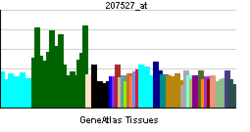KCNJ9
| KCNJ9 | |||||||||||||||||
|---|---|---|---|---|---|---|---|---|---|---|---|---|---|---|---|---|---|
| Identifiers | |||||||||||||||||
| Aliases | KCNJ9, GIRK3, KIR3.3, potassium voltage-gated channel subfamily J member 9 | ||||||||||||||||
| External IDs | MGI: 108007 HomoloGene: 37989 GeneCards: KCNJ9 | ||||||||||||||||
| |||||||||||||||||
| RNA expression pattern | |||||||||||||||||
 | |||||||||||||||||
| More reference expression data | |||||||||||||||||
| Orthologs | |||||||||||||||||
| Species | Human | Mouse | |||||||||||||||
| Entrez | |||||||||||||||||
| Ensembl | |||||||||||||||||
| UniProt | |||||||||||||||||
| RefSeq (mRNA) | |||||||||||||||||
| RefSeq (protein) | |||||||||||||||||
| Location (UCSC) | Chr 1: 160.08 – 160.09 Mb | Chr 1: 172.32 – 172.33 Mb | |||||||||||||||
| PubMed search | [1] | [2] | |||||||||||||||
| Wikidata | |||||||||||||||||
| View/Edit Human | View/Edit Mouse |
G protein-activated inward rectifier potassium channel 3 is a protein that in humans is encoded by the KCNJ9 gene.[3][4][5]
Function
Potassium channels are present in most mammalian cells, where they participate in a wide range of physiologic responses. The protein encoded by this gene is an integral membrane protein and inward-rectifier type potassium channel. The encoded protein, which has a greater tendency to allow potassium to flow into a cell rather than out of a cell, is controlled by G-proteins. It associates with another G-protein-activated potassium channel to form a heteromultimeric pore-forming complex.[5]
Interactions
KCNJ9 has been shown to interact with KCNJ6.[6][7]
See also
References
- ↑ "Human PubMed Reference:".
- ↑ "Mouse PubMed Reference:".
- ↑ Lesage F, Fink M, Barhanin J, Lazdunski M, Mattéi MG (Oct 1995). "Assignment of human G-protein-coupled inward rectifier K+ channel homolog GIRK3 gene to chromosome 1q21-q23". Genomics. 29 (3): 808–9. doi:10.1006/geno.1995.9928. PMID 8575783.
- ↑ Kubo Y, Adelman JP, Clapham DE, Jan LY, Karschin A, Kurachi Y, Lazdunski M, Nichols CG, Seino S, Vandenberg CA (Dec 2005). "International Union of Pharmacology. LIV. Nomenclature and molecular relationships of inwardly rectifying potassium channels". Pharmacological Reviews. 57 (4): 509–26. doi:10.1124/pr.57.4.11. PMID 16382105.
- 1 2 "Entrez Gene: KCNJ9 potassium inwardly-rectifying channel, subfamily J, member 9".
- ↑ Jelacic TM, Kennedy ME, Wickman K, Clapham DE (Nov 2000). "Functional and biochemical evidence for G-protein-gated inwardly rectifying K+ (GIRK) channels composed of GIRK2 and GIRK3". The Journal of Biological Chemistry. 275 (46): 36211–6. doi:10.1074/jbc.M007087200. PMID 10956667.
- ↑ Lavine N, Ethier N, Oak JN, Pei L, Liu F, Trieu P, Rebois RV, Bouvier M, Hebert TE, Van Tol HH (Nov 2002). "G protein-coupled receptors form stable complexes with inwardly rectifying potassium channels and adenylyl cyclase". The Journal of Biological Chemistry. 277 (48): 46010–9. doi:10.1074/jbc.M205035200. PMID 12297500.
Further reading
- Jelacic TM, Sims SM, Clapham DE (May 1999). "Functional expression and characterization of G-protein-gated inwardly rectifying K+ channels containing GIRK3". The Journal of Membrane Biology. 169 (2): 123–9. doi:10.1007/s002329900524. PMID 10341034.
- Schoots O, Wilson JM, Ethier N, Bigras E, Hebert TE, Van Tol HH (Dec 1999). "Co-expression of human Kir3 subunits can yield channels with different functional properties". Cellular Signalling. 11 (12): 871–83. doi:10.1016/S0898-6568(99)00059-5. PMID 10659995.
- Vaughn J, Wolford JK, Prochazka M, Permana PA (Aug 2000). "Genomic structure and expression of human KCNJ9 (Kir3.3/GIRK3)". Biochemical and Biophysical Research Communications. 274 (2): 302–9. doi:10.1006/bbrc.2000.3136. PMID 10913335.
- Jelacic TM, Kennedy ME, Wickman K, Clapham DE (Nov 2000). "Functional and biochemical evidence for G-protein-gated inwardly rectifying K+ (GIRK) channels composed of GIRK2 and GIRK3". The Journal of Biological Chemistry. 275 (46): 36211–6. doi:10.1074/jbc.M007087200. PMID 10956667.
- Lavine N, Ethier N, Oak JN, Pei L, Liu F, Trieu P, Rebois RV, Bouvier M, Hebert TE, Van Tol HH (Nov 2002). "G protein-coupled receptors form stable complexes with inwardly rectifying potassium channels and adenylyl cyclase". The Journal of Biological Chemistry. 277 (48): 46010–9. doi:10.1074/jbc.M205035200. PMID 12297500.
- Plummer HK, Dhar MS, Cekanova M, Schuller HM (2006). "Expression of G-protein inwardly rectifying potassium channels (GIRKs) in lung cancer cell lines". BMC Cancer. 5: 104. doi:10.1186/1471-2407-5-104. PMC 1208863
 . PMID 16109170.
. PMID 16109170.
External links
- KCNJ9 protein, human at the US National Library of Medicine Medical Subject Headings (MeSH)
This article incorporates text from the United States National Library of Medicine, which is in the public domain.